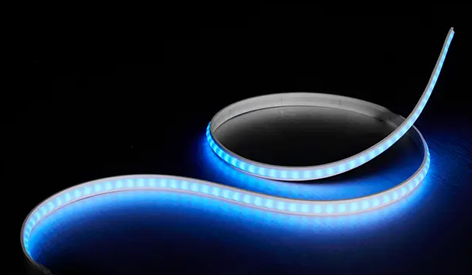Views: 0 Author: Site Editor Publish Time: 2025-07-17 Origin: Site
Flexible lighting strips, commonly known as LED strips or tape lights, have revolutionized the way we illuminate spaces. Their adaptability, energy efficiency, and vibrant lighting options make them popular choices for a wide variety of applications—from home decor to commercial advertising and industrial uses. Due to their versatility, flexible lighting strips come in many different types designed to meet specific functional needs and installation environments.
One of the primary considerations when selecting a flexible lighting strip is the color type. Color options influence the ambiance, functionality, and visual effect of the lighting.
Monochromatic LED strips emit a single color and are the simplest form of flexible lighting strips. The most common single colors are:
White Light: Used extensively for general illumination. White light is available in several shades, including:
Warm White (2700K–3500K): Creates a cozy, relaxing atmosphere similar to traditional incandescent lighting. Ideal for residential spaces such as living rooms and bedrooms.
Neutral White (4000K–4500K): Offers a balanced light, suitable for workspaces and kitchens where clarity is important.
Cool White (5000K–6500K): Bright and crisp, perfect for commercial areas, display cases, and task lighting.
Monochromatic strips are energy-efficient and provide consistent lighting suitable for accent lighting, under-cabinet illumination, and cove lighting.
RGB strips combine red, green, and blue LEDs that can mix to produce a wide spectrum of colors. These strips are popular in decorative lighting due to their ability to dynamically change colors and create captivating lighting scenes.
Dynamic Effects: Many RGB strips can be controlled to produce effects like fading, flashing, and color cycling.
Applications: Commonly used for mood lighting in bars, restaurants, gaming setups, stage design, and festive decorations.
However, standard RGB strips do not produce pure white light since white is a mixture of RGB colors, often appearing slightly tinted or less bright compared to dedicated white LEDs.
To overcome the limitations of RGB strips in producing true white light, manufacturers developed advanced types like RGBW and RGBCCT:
RGBW (Red, Green, Blue + White): Includes an additional dedicated white LED, allowing for both colorful effects and pure white illumination. This enables smooth transitions between colors and clean white light without color tint.
RGBCCT (Red, Green, Blue + Correlated Color Temperature Tunable White): Combines RGB LEDs with tunable white LEDs that can adjust color temperature from warm white to cool white. This offers the ultimate flexibility to set the ambiance from warm and cozy to bright and daylight-like.
These strips are ideal for applications requiring both vibrant colors and functional white light, such as high-end residential lighting, retail displays, and architectural accent lighting.
Voltage and length are critical factors affecting the performance, brightness, and installation flexibility of LED strips.
12V LED Strips: Widely used in residential and commercial applications. They offer a good balance between brightness and safety. 12V strips generally allow lengths up to 5 meters per power feed before voltage drop becomes noticeable.
24V LED Strips: Preferred for longer runs, especially when the lighting strip length exceeds 5 meters. Because of the higher voltage, 24V strips can deliver power more efficiently over longer distances, reducing voltage drop and maintaining brightness.
LED strips commonly come in reels of 5 meters or 10 meters. Beyond these lengths, voltage drop — the gradual loss of voltage along the strip — can cause uneven brightness. To address this:
For 12V strips, it's common to limit individual runs to 5 meters and use multiple power feeds or amplifiers for longer installations.
For 24V strips, runs of up to 10 meters or more are feasible without significant voltage drop.
When designing a lighting project, it’s important to consider the power supply rating, total strip length, and the need for additional connectors or amplifiers to maintain consistent lighting quality.

The environment in which LED strips are installed greatly influences the required protection level. Flexible lighting strips are available with different waterproof ratings to suit indoor or outdoor usage.
These strips are not coated or sealed and are intended for dry, indoor environments. They are lightweight, easy to cut and install, and offer maximum flexibility for applications like:
Under-cabinet kitchen lighting
Closet and shelf illumination
Decorative cove lighting in living spaces
Since they lack protective coatings, they must be kept away from moisture and dust.
Semi-waterproof LED strips are coated with a thin layer of epoxy or silicone resin (often called “potting” or “drip coating”). This provides protection against accidental water splashes, dust, and humidity.
Commonly used in:
Bathrooms and kitchens where moisture may be present but direct water contact is unlikely
Outdoor eaves and under sheltered areas
Signage with some exposure to weather
They offer a good compromise between flexibility and protection.
Fully waterproof LED strips are encased inside silicone or polyurethane tubes, providing IP65 to IP68 ratings that protect against heavy rain, immersion, and outdoor elements.
Applications include:
Outdoor architectural lighting
Garden and landscape illumination
Pools and fountains
While offering maximum durability, these strips are less flexible and slightly bulkier due to their protective casing.
Flexible LED strips are extraordinarily versatile and have found their way into numerous lighting applications.
Flexible LED strips are ideal for modern indoor décor. They are widely used for:
Accent lighting behind TVs or monitors
Under cabinet lighting in kitchens for task illumination
Cove and ceiling perimeter lighting to create ambient glow
Staircase and hallway illumination to enhance safety and style
The ability to customize color and brightness levels enables users to create moods from subtle warmth to vibrant energy.
In commercial environments, flexible lighting strips illuminate signs, window displays, and exhibition booths. Their dynamic color options (RGB, RGBW) draw attention and enhance branding efforts.
Light boxes and channel letters often use waterproof LED strips to ensure durability.
Backlighting for retail shelves and product showcases improves visibility and highlights merchandise.
Flexible LED strips are popular in vehicle customization:
Interior ambient lighting for cars and trucks
Underglow lighting for aesthetic enhancement
Truck bed and cargo lighting for utility and safety
Due to the vibration and exposure in vehicles, waterproof or semi-waterproof LED strips with robust installation are preferred.
Industrial environments use LED strips to mark pathways, highlight hazards, or illuminate control panels. Bright, durable strips with specific color temperatures improve visibility and safety compliance.
Flexible lighting strips come in a wide variety of types to meet diverse lighting needs, from simple single-color white LEDs to advanced RGBW and tunable white options. Understanding the differences in color types, voltage specifications, and protection levels helps users achieve the desired lighting effects while ensuring stable brightness and safe installation. Whether creating a cozy home atmosphere or enhancing the visual impact of commercial signage, flexible LED strips offer unmatched versatility and energy efficiency, making them an essential tool in modern lighting design.
For those looking to explore high-quality, customizable flexible LED strip solutions, ORIENT LIGHTING Co., Ltd. is a trusted industry leader. With a comprehensive product range and expert technical support, Orient Lighting can help you bring your lighting ideas to life with precision and reliability. Visit their official website at www.orientlighting.com to learn more, or contact their team directly for professional advice and personalized service. Illuminate your space with confidence by partnering with experts who understand your unique lighting needs.
INTEGRATE™ is a series of integrate flexible LED strips including single White, single Color, variable white, RGB, RGB pixel, RGBW and RGBVW. Various types would meet any your customized requirements. Integrate has dome surface as COB for soft and dot-less effect, same SMD technology as lighting sou
Flexible SMD LED strip lights have become one of the most popular lighting solutions in both residential and commercial environments. Their slim profile, low power consumption, and versatility make them suitable for accent lighting, task lighting, decorative installations, and even large-scale architectural illumination. Among the wide range of LED chips available today, SMD 3528 and SMD 5050 remain two of the most commonly used and widely recognized options.
SMD LED strip lights have become one of the most versatile and popular lighting solutions in modern homes, commercial environments, and creative projects. Their slim profile, flexible design, and energy efficiency make them ideal for accent lighting, task lighting, ambient illumination, and decorative installations. Yet one of the biggest questions users have—especially beginners—is whether SMD LED strip lights can be cut without damaging them.
LED strip lighting has become one of the most versatile and widely adopted solutions for modern residential, commercial, and architectural lighting. Among the different types of LED strips available today, SMD LED strip lights and COB LED strips are the two most popular choices. Each offers unique advantages, performance characteristics, and visual effects, making them suitable for different applications.
SMD LED strip lights have become one of the most versatile and widely used lighting solutions for residential, commercial, and industrial applications. From accent lighting in living rooms to large architectural installations and retail displays, LED strips offer flexibility, efficiency, and precise illumination control. However, managing long LED strips—especially those stretching beyond 5–10 meters—comes with unique challenges.
LED lighting has revolutionized the way homes, commercial spaces, and decorative environments are illuminated. Among the most popular modern lighting solutions, LED flexible strip lights stand out because they combine versatility, energy efficiency, and sleek aesthetics. Within this category, SMD LED strip lights have become the industry standard due to their compact size, strong brightness, and adaptability to a wide range of applications.
In the world of modern lighting, few products have transformed interior and exterior illumination as dramatically as SMD LED strip lights. Whether used for home decoration, retail ambiance, architectural highlights, or industrial applications, these flexible and efficient lighting tools offer unparalleled versatility. Their slim design, excellent brightness, and wide color options have made SMD LED strips a preferred choice for designers, homeowners, and engineers alike.
Light and color have long been understood to influence human emotions, behavior, and even physical well-being. From the moment we wake up to the time we go to sleep, the type of light surrounding us plays a vital role in shaping our moods, productivity, and overall state of mind. This is why understanding the psychology of light and color is crucial when selecting LED lighting for various environments, whether it's at home, in the office, or in commercial settings.
LED strip lights are a popular choice for modern lighting due to their energy efficiency, versatility, and sleek design. However, one crucial aspect that is often overlooked when using LED strips is thermal management. LED lights, like any other electronic component, generate heat as they operate, and if not properly managed, this heat can reduce their performance and lifespan.
Choosing the right LED strip lights for your home or office is a decision that requires careful consideration. LED strips have become an increasingly popular choice due to their versatility, energy efficiency, and aesthetic appeal. However, with so many options available on the market, it’s easy to feel overwhelmed by the number of different types and features.
Indirect lighting has become a popular choice for creating a soothing and stylish ambiance in both residential and commercial spaces. Unlike direct lighting, which often creates harsh shadows and bright spots, indirect lighting provides a more gentle and even illumination that enhances the atmosphere without overwhelming the eyes.
Proper lighting on boats or yachts is not just about enhancing the aesthetic appeal; it plays a crucial role in ensuring safety, functionality, and comfort on the water. Effective lighting can help improve visibility during nighttime navigation, set the mood for evening activities, and highlight specific areas of your vessel. One of the best lighting options for marine environments is LED strip lights. Their versatility, energy efficiency, and durability make them an excellent choice for a variety of marine applications.
To ensure that your LED strip lights continue to perform at their best and last as long as possible, proper care and installation are essential. LED strips are known for their longevity and energy efficiency, but several factors can influence how long they last. By following some simple yet effective maintenance tips, you can extend the lifespan of your LED strips and keep them running smoothly for years to come.
When purchasing LED strip lights for your home or business, you might notice various certifications listed on the product packaging or technical specifications. These certifications, often represented by logos or marks, indicate that the product has met specific safety, environmental, and quality standards. Understanding what these certifications mean can help you make informed decisions, ensuring you choose a reliable and safe lighting solution.
LED strip lights are a fantastic way to add vibrant lighting to your home or workspace, offering versatility and energy efficiency. However, when it comes to installation, there are common mistakes that many people make, which can negatively affect the performance, lifespan, and overall functionality of the LED strips. Whether you're a seasoned DIYer or a first-time installer, it's crucial to avoid these common errors to ensure your LED lights shine brightly and last for years to come.
Flexible lighting strips, commonly known as LED strips or tape lights, have revolutionized the way we illuminate spaces. Their adaptability, energy efficiency, and vibrant lighting options make them popular choices for a wide variety of applications—from home decor to commercial advertising and industrial uses.
In recent years, flexible lighting strips have become increasingly popular not just for indoor use, but also as a creative and practical solution for outdoor lighting applications.
Flexible LED strip lights have rapidly gained popularity in both residential and commercial lighting applications. Their versatility, energy efficiency, and ease of installation make them an excellent choice for accent lighting, decorative purposes, and practical illumination alike.
Flexible lighting strips, commonly known as LED strip lights, are thin, versatile lighting fixtures that consist of small light-emitting diodes (LEDs) mounted on a flexible circuit board.
In the world of modern lighting, flexible lighting strips—also known as LED strip lights or ribbon lights—have revolutionized how we illuminate spaces. These thin, adaptable lighting solutions offer not only energy efficiency but also unmatched versatility, making them a top choice for a wide range of residential, commercial, and industrial applications.


